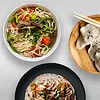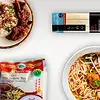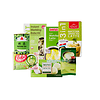Kishimen is a variety of udon noodles that are flat and larger than traditional udon. Read more
Kishimen is a variety of udon noodles that are flat and larger than traditional udon. Toa Foods makes kishimen following a traditional method from Hyogo and more specifically from Harima, which was previously named Banshuu, located in central Japan and renowed for its dry noodle production.
Flavor : Kishimen are flat noodles with a firm and smooth texture.
Use : Similar to udon, kishimen noodles can be eaten paired with dashi or tsuyu stock, in a soup, with a sauce or stir fried, like a pad thai for example.
Cooking instructions : Cook in a large volume of water for 5-6 minutes.
Ingredients :Wheat flour (92,3%), modified starch (4,4%), salt (3,3%)
| Portion | 100g |
|---|---|
| Energy | 1423 KJ / 340 kcal |
| fats | 0.89 g |
| Saturated fat | 0.25 g |
| trans fat | |
| carbohydrates | 74.4 g |
Preservation : Keep at room temperature, away from sunlight, heat and moisture.
Founded in 1945 in Himeji, Hyogo prefecture, Toa Foods specializes in noodle manufacturing. Consumed for over 1,300 years on the archipelago, noodles are deeply embedded in Japanese culture. The region of Himeji, formerly known as Banshu, is known for its production of hand stretched dry noodles with a unique taste that requires plenty of skills. Among the 50 employees of Toa Foods, 11 of them are nationwide recognized noodle experts that oversee the manufacturing process of soba, ramen, udon and much more. To do so, the company uses high quality products supplied by the best Japanese companies such as wheat flour and locally grown rice called Japonica rice, used to make rice flour. The production process of noodle is unique and divided into several steps to ensure the preservation of the flavor of each ingredient. Nowadays, Toa Foods wishes to represent Japan and its rich cuisine on the international stage thanks to its soba, udon or even high quality ramen.




 New Arrivals
New Arrivals
 Search by country
Search by country
 Search per category
Search per category
 Specials
Specials
 Outlet
Outlet
 Matcha
Matcha
 Tjin's Blog
Tjin's Blog
